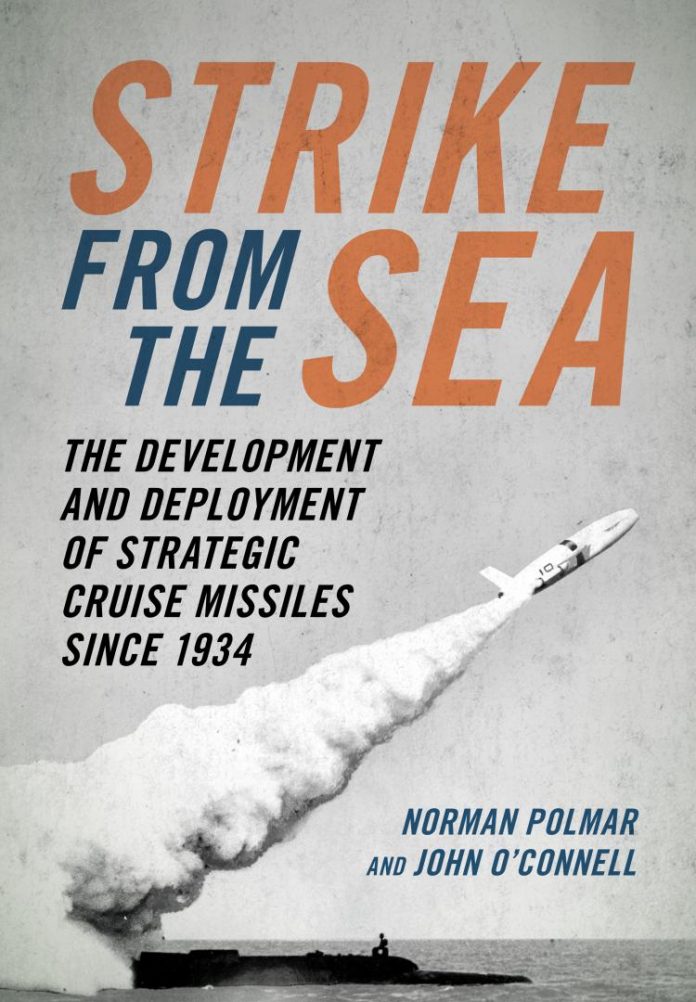
Strike from the Sea. The Development and Deployment of Strategic Cruise Missiles since 1934. By Norman Polmar and John O’Connell. Annapolis, Naval Institute Press, 2020. ISBN 9781682473894 (hardback edition)
Reviewed by David Hobbs
The book’s title gives a very prescriptive impression of the subject matter and I began to realise just how narrow it was as I read into it and found descriptions of some weapons that fell outside it and the omission of related cruise missiles that would have been interesting.
In their opening perspective the two authors define ‘strategic’ as a weapon designed to strike an enemy homeland, military/industrial centre or population centre. Cruise missiles are defined as unmanned, expendable, aerodynamic vehicles usually propelled by an air-breathing (jet) engine. Some types of cruise missile, such as the Soviet Styx or the French Exocet, fall outside these strict definitions but are mentioned as being propelled by rockets rather than air-breathing engines. No mention is made of the longer-ranged, air-breathing British Sea Eagle. In view of these strict definitions, the authors’ opening pages describing 1920s era submarines armed with large-calibre guns such as the British M 1 are rather unexpected. These were intended for cruiser warfare against shipping in the open ocean, not attacks on land targets. I was very surprised that there is no reference to the British Larynx project, carried out between 1925 and 1927. This was an unmanned air vehicle designed from the outset to carry out land-attack missions from a ship at sea; a role that placed it exactly within the authors’ title and definitions if not their stated time frame. It was referred to at the time as a ‘flying bomb’ but was in all respects what we would now call a cruise missile. It was remotely-piloted, powered by a 200 hp radial engine, contained 250lb of explosive and was capable of attacking targets up to 300 nautical miles from the launching ship. Six development air vehicles were tested with the first launched from the destroyer Stronghold by catapult in July 1927. The project was cancelled later in 1927 after the RAF expressed fears that the technology could make manned bombers obsolete.
The date chosen for the title, 1934, ought to have excluded the submarine cruisers but was no doubt chosen as the year in which the German engineer Paul Schmidt proposed a ‘flying bomb’ that evolved into the V-1 and the authors describe the development of this Luftwaffe ‘vengeance weapon’ and that of the contemporary German Army V-2 ballistic missile in some detail although neither was ever intended to ‘strike from the sea’. Early V-1s had a range of only 160 nautical miles, half that of that demonstrated by the Larynx air vehicle over a decade earlier. US Navy interest was sparked in 1945 when a number of V-1s were captured and reverse-engineered copies evolved into the Loon submarine-launched cruise missile which was deployed operationally in small numbers. The book’s greatest strength lies in its description of Loon and the subsequent Regulus I and II cruise missiles which were deployed operationally by the USN in the 1950s. The authors acknowledge that they owe a considerable debt to the seminal work of David K Stumpf PhD in his book Regulus: The Forgotten Weapon published in 1996 and one of them actually served in a Regulus-armed submarine so it is only to be expected that the chapters devoted to this weapon would be both detailed and interesting.
Two chapters are devoted to explaining the Soviet perspective and, whilst interesting, these suffer from the work’s narrow definitions in that they only describe the land attack aspects of cruise missiles deployed operationally in surface ships and submarines. The first missile described, therefore, is the SS-N-3 Shaddock because it had a land-attack application. A short description of SS-N-1 Styx would have been interesting since it was the first cruise missile to sink a warship when fired from the sea. The omission is even more disappointing because Styx could have been compared with Shaddock and later missiles which also had over-the-horizon anti-ship capabilities at steadily increasing ranges using mid course guidance from aircraft or other vessels including submarines. The authors digress to describe the T-15 nuclear torpedo which could have been used to attack either ports and land defences or aircraft carrier task groups so why not mention Styx and its early successes? There are, in any case, other digressions as the text includes brief descriptions of USAF and Army land-based tactical cruise missiles such as Gryphon, Mace, Matador, Navaho and Snark which cannot be described as striking from the sea. The last chapters describe the various versions of the Tomahawk cruise missile, BGM-109, used principally by the US and Royal Navies for land-attack missions which fit within the title’s strict definitions. Here too there are digressions, however, because there are also anti-surface vessel versions of Tomahawk and their specialised warheads are actually illustrated in Appendix B. No mention is made of the British air-launched cruise missile Blue Steel and its USAF contemporary Hound Dog is only mentioned obliquely on one page; neither is compared with the systems that are mentioned. There are source notes, five pages of bibliography and an index. By the way, the domed building in the photograph on page 12 is the Methodist Central Hall in Westminster, not St Paul’s Cathedral as captioned.
Overall, this book gives very good insight into the design and deployment of Regulus I and II and the perceived comparison of life at sea with it compared with the early Polaris boats, as one would expect from a senior officer who had served in a guided-missile submarine. These are its strengths. In my opinion, the remainder of the text, whilst adding to the historiography of cruise missiles could have been improved by the inclusion of Larynx and the early Soviet anti-ship cruise missiles, making space if necessary by deleting the unnecessary description of British, French and American gun-armed submarine cruisers. I would certainly recommend this book to anyone with an interest in the development and deployment of Regulus however, a better understanding of Soviet/Russian cruise missile evolution could be gained from studying The Naval Institute Guide to World Naval Weapon Systems.



